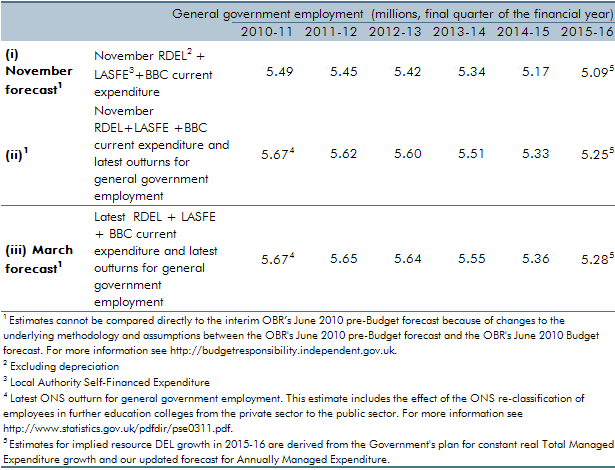Our general government employment (GGE) forecast is based on projections of the growth of the total government paybill and paybill per head, which is in turn based on the Government's latest spending plans. Ahead of our March 2011 forecast, ONS estimates of general government employment were revised up, largely reflecting the reclassification of employees in further education colleges. In this box we set out the extent to which changes to our general government employment forecast were a result of our revised projections for paybill growth as opposed to data revisions.
For our projection of general government employment we have maintained the same topdown approach we used for our November forecast, combining estimates of paybill growth and the growth of paybill per head to generate a forecast for employment growth.a
Since November, we have updated our projections for paybill growth, which are based on growth in the sum of RDEL, LASFE and BBC current expenditure. Taking into account latest outturn information, the latest projections imply growth in the sum of RDEL, LASFE and BBC current expenditure of just over 2.6 per cent between 2010-11 and 2014-15, compared to 2 per cent in our November forecast. All else equal, this implies a slightly smaller reduction in general government employment over this period than in our November forecast.
The level of general government employment in the past has also been revised up since November, largely reflecting the ONS re-classification of employees in further education colleges from the private sector to the public sector. The effect of this has been to move around 220,000 employees from the private sector to the public sector from 1999. For any given percentage change in projected workforce growth, this upward revision implies a greater absolute change in general government employment over the projection period.
Table A sets out:
- our November forecast for general government employment;
- the profile for general government employment using our November projections for RDEL, LASFE and BBC current expenditure, but with the latest ONS outturns for general government employment; and
- our updated forecast for general government employment, based on the latest ONS outturns and our updated projections for RDEL, LASFE and BBC current expenditure.
The difference between (i) and (ii) provides an estimate of the impact of ONS data revisions (including the reclassification of employees working in further education colleges) to our forecast of general government employment, while the difference between (ii) and (iii) indicates the effect of our updated projections for RDEL, LASFE and BBC current expenditure. Our latest forecast implies a reduction in general government employment of around 310,000 between 2010-11 and 2014-15, compared to the reduction of around 330,000 implied by our November forecast. Of the change since November, changes to growth in the sum of RDEL, LASFE and BBC current expenditure reduce the implied reduction in general government employment by around 30,000. This is partially offset by the effect of the ONS upward revision to the level of general government employment, which increases the absolute reduction in general government employment between 2010-11 and 2014-15 by around 10,000.b Our implied forecast for RDEL, LASFE and BBC current expenditure implies a further reduction in general government employment of around 90,000 between 2014-15 and 2015-16, bringing the total decline over five years to around 400,000.
The sensitivity of these projections to relatively small adjustments to government expenditure forecasts is one drawback of using a top-down approach to forecast general government employment. But this is the best approach available until the Government obviates the need for a forecast by publishing specific workforce plans.
Table A: General government employment

